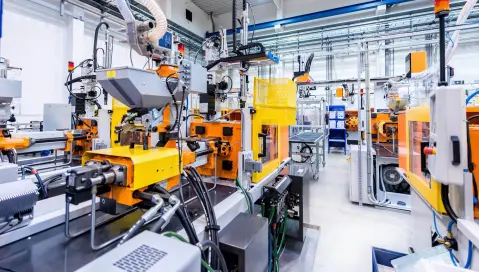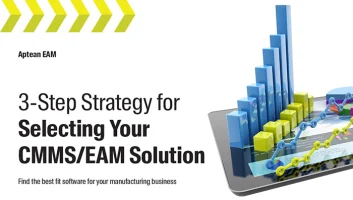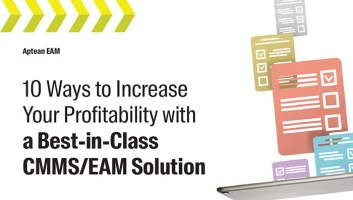Destacado en este post
Your Quick and Easy Guide to Enterprise Asset Management (EAM) Software
Your Quick and Easy Guide to Enterprise Asset Management (EAM) Software
Abr 21, 2022
Aptean Staff Writer
If you’re in manufacturing, you know that your assets are crucial to keeping your business running. Manufacturing is, by nature, asset intensive. If you want to stay ahead of the competition, save money and run at peak efficiency, you need real-time data regarding the performance and condition of your fixed assets.
Unplanned downtime costs manufacturers some 800 hours at a whopping $260,000 per hour. This equates to $50 billion per year. So, optimizing the performance of your assets really is a no-brainer.
The manufacturing industry relies on the continued output of their physical assets, so keeping equipment in perfect working order is mission critical and cannot be done correctly through manual processes. Enter enterprise asset management, or EAM. This software combines maintenance and management tools with connected devices across all sites, lines and teams. If you’re trying to run a manufacturing business, you need EAM to minimize costly downtime, prolong the lifespan of your assets and achieve shop floor excellence.
In this guide, we’ll cover exactly what EAM is, its many benefits to your organization and what features you should look for. Let’s dive in.
What Is EAM?
Enterprise asset management (EAM) is comprehensive software used to maintain and control operational assets and equipment. For manufacturers, it helps maintain the quality and utilization of assets throughout their lifecycle, increases productivity and ultimately reduces costs.
Using advanced analytics within the EAM, management and maintenance teams can optimize asset performance, minimize asset downtime and reduce maintenance costs. In addition, EAM best practices help maintenance teams gain greater control of complex environments and access actionable insights across all sites, lines and teams. Your asset managers and maintenance crews will have all the tools and insights they need to predict asset behavior and stay proactive with crucial maintenance schedules.
What’s the Difference Between EAM and CMMS?
In doing even the most basic search or preliminary research on EAM, you’ll no doubt come across the term computerized maintenance management system (CMMS) too. So, let’s quickly cover the main difference between these two systems.
CMMS and EAM systems have similar purposes and some of the same functionality. For small businesses, a CMMS is a great entry-level product to help manage your assets. However, EAM systems offer a much broader range of features. The biggest difference between the two is in scope.
A CMMS only focuses on maintenance, while an EAM system takes a more comprehensive approach and has multiple business functions.
A CMMS starts tracking only after installation of an asset while an EAM system tracks assets throughout their lifecycle.
A CMMS is generally limited to single sites or has very limited multisite capabilities, whereas an EAM can easily manage multiple sites and even different businesses.
A CMMS is a great starting point for small operations—however, bear in mind that a CMMS is not scalable.
If an EAM seems too expensive right now, think about this—one bad review online can cost you thirty customers, whereas preventive maintenance will save you five dollars on other expenses. An EAM is a CMMS combined with inventory management, purchasing management, document management, accounting and even business intelligence. If you want to grow your business the ROI on an EAM more than compensates for the initial cost.
EAM Benefits
If you’re trying to manage your assets through manual means, you will face constant challenges. It’s like trying to roll a stone uphill. For example, you must calculate depreciation by hand; spend hours on phone calls to maintenance personnel; and you may neglect health and safety procedures because you don’t have up-to-date information.
If you’re experiencing frequent equipment failures, your Maintenance, Repair & Operations (MRO) spending is too high or if it’s difficult to keep up with your maintenance procedures, EAM is a necessity. With EAM you can automate labor-intensive, manual processes like work orders, asset maintenance schedules, parts procurement and even health and safety initiatives. In a nutshell, EAM gives you a detailed view of your entire repository of fixed assets. The main benefit of EAM is that it helps your team implement a prescriptive, proactive, data-driven strategy of your asset health. It maximizes asset usability and improves profitability.
Here are some of the benefits that you could realize with EAM.
Centralized asset information. No matter how big or small your enterprise is, you still need access to data. A robust EAM tells maintenance managers where an asset is and gives detailed information about if and when it will need maintenance. You’ll also get alerts if any anomalies occur and asset management workflows can be automated, making them accessible to everyone that needs them.
Proactive and preventive maintenance. EAM has preventive capabilities to maintain equipment to keep operations continuous. It ensures warranty compliance and prevents issues that could disrupt productivity. Users have access to all pertinent information, including work orders, parts and even failure analysis codes.
Strategic analytics to monitor assets. Remote monitoring delivers actionable insights into both the current and expected states of your assets. It aggregates data across departments, which gives everyone access to the same information. You get fewer alerts and enjoy enhanced decision-making.
Maximize asset utilization. By combining historical and real-time data, users get reports and diagnostic tools to help extend the reliability and lifespan of assets.
Workflow management. EAM can establish digital workflows to keep everyone informed about the state of all assets in real time. This ensures accountability—so there’s no more guessing about who is responsible for what. You can set up guidance-based approvals, reminder notifications and any other tasks, all based on your specific pre-defined conditions.
Task automation. EAM lets you automate repetitive tasks like asset maintenance, ordering parts and restocking inventory. With an EAM, managers can focus on high-impact tasks and your asset managers and maintenance teams won’t have to waste time on countless administrative activities like manual data entry.
Inventory management. An EAM system can manage your organization's inventory with just a few clicks. With easily configurable dashboards, your procurement managers will know the status of all inventory which reduces the risk of over or under stocking parts and supplies.
Service and work order management. Asset maintenance is imperative for your enterprise. This means that routine asset maintenance activities need to be scheduled regularly, whether you use an in-house team or outside technicians. Trying to juggle hundreds of contacts and get someone out every time that something goes wrong would be almost impossible with manual processes. An EAM solves this issue with built-in service management modules. This functionality assigns, manages, tracks MRO operations and shares the progress of repairs or maintenance.
5 Features You Need With Enterprise Asset Management Software
Not all EAM software is created equal. You need an EAM that is built by manufacturers, for manufacturers. A generic solution will be able to perform some of the tasks you need but may not have all the features required to embrace an intelligent, data driven asset management strategy. When you’re looking at EAM packages, here are five must-have features.
1. Mobile apps and SaaS. With so many companies moving to remote work, you need your team to have access to all your information no matter where they log on. In addition, your field and in-house service reps need to know where to be, what to do and what time to be there—and they need to be able to get that information on the go. In addition, management can send reviews or approvals from their phones or tablets. SaaS EAM software also means enhanced security.
2. Dashboards. User-friendly, configurable dashboards give your teams a bird's-eye view of critical asset data points, such as predictive maintenance (PM) compliance rate, open work orders and downtime hours.
3. Audit and regulatory compliance. With an EAM, you can guarantee constant governance of all regulatory and compliance standards for your industry, giving you peace of mind that you’re always compliant. You can also perform inspections from anywhere.
4. Multiple warehousing. Your EAM should be scalable, which means it grows with you. It should support multiple locations, warehouses and facilities and allow you to transfer materials and assets between them.
5. Analytics and forecasting. Maintenance shouldn’t be a reactive activity so your EAM should empower you to look ahead. For example, our enterprise asset management solution, Aptean EAM, has a configurable maintenance Business Intelligence (BI) solution that gives instant insight into the unique KPIs and metrics that are important to your organization’s success. This helps with preventive maintenance and predictive maintenance and allows you to run extended and enhanced analytics to gain operational insights.
The Road to Intelligent Asset Management
An enterprise asset management solution helps to get the most out of your assets and your operation. You will know how those assets are performing in real time and can predict which will need repairs or maintenance.
If you’re still trying to run your manufacturing enterprise with spreadsheets and manual processes, you won’t always know what’s happening across your business. You may not have the right solution or the right parts on hand. The manuals might get lost, or the technician might be new and not know about your particular assets.
What if you could take asset management to the next level? What if you could achieve shop floor excellence with a maintenance intelligence solution? You know that the manufacturing industry is competitive, with everyone vying for the same customers. With EAM, you get your products to market faster; you operate more efficiently; and you maximize profitability.
Aptean’s EAM systems go even further by offering advanced, industry-specific EAM software that is designed to master your unique challenges.
Want to learn more about how EAM can boost your operation’s visibility and efficiency? Reach out—we’d love to talk.
Related Content


¿Todo listo para transformar tu negocio?
Tenemos las soluciones EAM especializadas que necesitas para superar los desafíos de tu sector.






